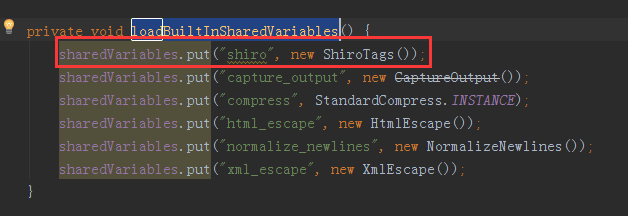
最近在做权限控制的时候用到了shiro,可惜一窍不通,学了一段时间之后,在freemarker装饰器中集成shiro标签时遇到了一点问题,网上资料都是在普通页面实现,特此记录下,如有理解不对的地方还请各位指正。
1、需要引入jar包,或者到github上下载源码打包使用:
2、集成freemarker的配置类FreeMarkerConfigurer,重写afterPropertiesSet()方法:如下
import com.jagregory.shiro.freemarker.ShiroTags; import freemarker.template.TemplateException; import org.springframework.web.servlet.view.freemarker.FreeMarkerConfigurer; import java.io.IOException; /** * 继承FreeMarkerConfigurer类,重写afterPropertiesSet()方法; * 集成shiroTags标签 * Created by zsc on 2016/1/5. */ public class ShiroTagFreeMarkerConfigurer extends FreeMarkerConfigurer { @Override public void afterPropertiesSet() throws IOException, TemplateException { super.afterPropertiesSet(); this.getConfiguration().setSharedVariable("shiro", new ShiroTags()); } } 3、修改freemarker的xml配置文件:把freemarkerConfig bean的class指向自定义的ShiroTagFreeMarkerConfigurer,如下
0 utf-8 \#0.\#\#\#\#\# yyyy-MM-dd HH:mm:ss true ignore
4、包含以下标签
guest标签:验证当前用户是否为“访客”,即未认证(包含未记住)的用户; shiro标签:<shiro:guest> </shiro:guest> ; freemark中: <@shiro.guest> </@shiro.guest>
user标签:认证通过或已记住的用户 shiro标签:<shiro:user> </shiro:user> ;freemark中: <@shiro.user> </@shiro.user>
authenticated标签:已认证通过的用户。不包含已记住的用户,这是与user标签的区别所在。 shiro标签: <shiro:authenticated> </shiro:authenticated>; freemark中: <@shiro.authenticated> </@shiro.authenticated>
notAuthenticated标签:未认证通过的用户。与authenticated标签相对。 shiro标签:<shiro:notAuthenticated> </shiro:notAuthenticated>;freemark中: <@shiro.notAuthenticated></@shiro.notAuthenticated>
principal标签 : 输出当前用户信息,通常为登录帐号信息 shiro标签: Hello, <@shiro.principal property="name" /> ; freemarker中: Hello, <@shiro.principal property="name" />, how are you today?
hasRole标签 :验证当前用户是否属于该角色 ,shiro标签: <shiro:hasRole name="administrator"> Administer the system </shiro:hasRole> ; freemarker中: <@shiro.hasRole name=”admin”>Hello admin!</@shiro.hasRole>
hasAnyRoles标签: 验证当前用户是否属于这些角色中的任何一个,角色之间逗号分隔 ,shiro标签: <shiro:hasAnyRoles name="admin,user,operator"> Administer the system </shiro:hasAnyRoles> ; freemarker中: <@shiro.hasAnyRoles name="admin,user,operator">Hello admin!</@shiro.hasAnyRoles>
hasPermission标签: 验证当前用户是否拥有该权限 ,shiro标签: <shiro:hasPermission name="/order:*"> 订单 </shiro:hasPermission> ; freemarker中: <@shiro.hasPermission name="/order:*">订单/@shiro.hasPermission>
lacksRole标签 :验证当前用户不属于该角色,与hasRole标签想反,shiro标签: <shiro:hasRole name="admin"> Administer the system </shiro:hasRole> ;freemarker中:<@shiro.hasRole name="admin">Hello admin!</@shiro.hasRole>
lacksPermission标签:验证当前用户不拥有某种权限,与hasPermission标签是相对的, shiro标签: <shiro:lacksPermission name="/order:*"> trade </shiro:lacksPermission> ; freemarker中: <@shiro.lacksPermission name="/order:*">trade</@shiro.lacksPermission>
5、 注意:此情况只是对没有使用sitemesh有效,若freemarker使用了装饰器模板来对返回页面进行装饰,这些标签只能用在返回的ftl页面中,而不能用在模板ftl中,include引入的会解析不了。
解决上述问题,可以通过修改freemarker的重写覆盖源码的Configuration类来实现,这样做的话不仅可以实现上述集成的效果,而且还避免的装饰页面不生效的问题,具体做法如下:
1、将 freemarker.template. Configuration.java中的源码复制到项目中,包命名和类命名与之完全相同,修改自己复制后的类中loadBuiltInSharedVariables()方法,添加sharedVariables.put("shiro", new ShiroTags());,如下:ShiroTags是上述shiro-freemarker-tags.jar中定义的。

2、修改web.xml文件,如下,红色字体是需要在shiroFilter中配置的,因为动态请求页面中的标签是通过REQUEST获取的,而静态装饰页面中的标签是通过FORWARD或者INCLUDE获取的,否则在解析标签时获取不到当前用户的subject信息。另外,shiroFilter建议配置在sitemesh之前。
shiroFilter org.springframework.web.filter.DelegatingFilterProxy true targetFilterLifecycle true shiroFilter *.htm REQUEST FORWARD INCLUDE sitemesh com.opensymphony.module.sitemesh.filter.PageFilter sitemesh /*
也可以到我的CSDN博客大家讨论